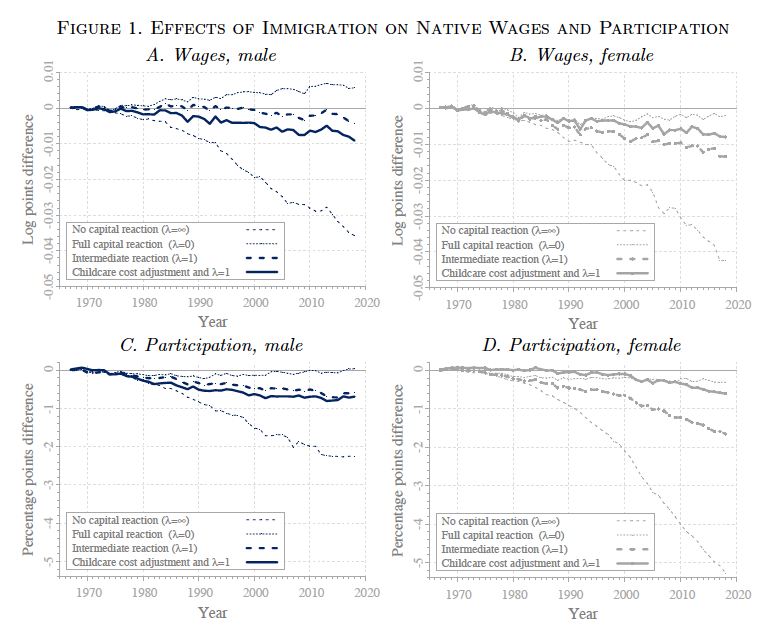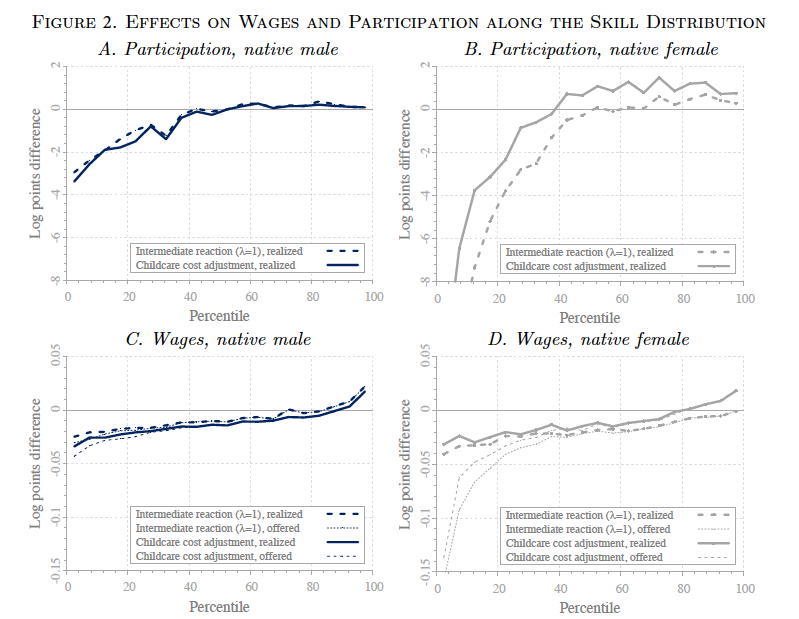Original photo: Ketut Subiyanto / Pexels
Over the past decades, two phenomena have attracted the attention of labor economists: the ever-increasing immigration level and the evolution of gender differences in the labor market. Given the persistent gender disparities in wages and labor market participation, trying to understand how the first affects the latter is a pressing matter.
In Barcelona Working Paper 1217, “Immigration and Gender Differences in the Labor Market,” Joan Llull studies the effect of immigration on gender gaps in the labor market. Using a structural model for the U.S. economy, he empirically quantifies the importance of two mechanisms: the differential labor market competition induced by immigration on male and female workers, and the availability of cheaper childcare services.
The novel and perhaps surprising findings show that the overall average effects of immigration on gender gaps are negligible. However, there is an important degree of heterogeneity of these effects, and while gender gaps are reduced by immigration at some points of the skill distribution, they are substantially increased in others.
An empirical model of labor supply, human capital and immigrants
The paper argues that there are two confronting forces by which immigrants can affect gender gaps. Firstly, they differently increase labor market competition experienced by males and females. Secondly, they reduce the prices of household services such as child-care, which, in traditional societies reduces the opportunity cost of female labor supply. These two mechanisms not only influence labor supply decisions and wages contemporaneously, but they also influence career prospects and incentives to invest in human capital.
The paper uses an estimated structural model that accounts for labor supply and human capital adjustments by natives and established immigrants to quantify the role of two mechanisms in affecting gender gaps: labor market competition and the availability of cheaper childcare services.
Quantifying the effects of immigration
Using data from the U.S. for the period 1967-2018, the author disentangles the competition and childcare effects argued above by simulating the counterfactual U.S. economy in the absence of immigration. In particular, two types of simulations are considered. The first set assumes that immigration influences labor market prospects of natives and immigrants, but does not influence childcare costs. These simulations describe the competition effect. They account for the different competition of immigrants on male and female workers, affecting relative wages and hence labor supply and human capital decisions.
In the second set of counterfactual exercises, the author also accounts for the reduction in childcare costs induced by immigration. Specifically, immigration makes the staying-home alternative less attractive for females when they have young children, as the savings of childcare costs associated with staying home are smaller. Therefore, these simulations quantify the overall effect.
In each of these scenarios, the author analyzes three sets of outcomes. First, he quantifies the effect on the average wage and labor force participation gender gaps for the period 1967-2018. Second, he analyzes the effects on gender gaps along the skill distribution, to unfold heterogeneity in the effects of immigration. Finally, he explores the mechanisms by which different natives adjust their human capital (education, occupation, and work experience) differently.
On aggregate, competition effects appear to be more severe for women. However, the availability of cheaper childcare services compensates these effects to some extent. Figure 1 illustrates these conclusions.
Note: The figure represents the difference between baseline and counterfactual average wages and labor force participation rates for native males and females under the four counterfactual scenarios indicated by the legend. Plotted lines represent average effects for natives aged 25-54.
When only competition effects are accounted for, aggregate female wages and participation are more negatively affected than male counterparts. On average, female wages are reduced by around 1.4%, whereas male wages are only reduced by 0.4%. Participation rates are reduced by 1.6 and 0.6 percentage points respectively. However, when the effects on childcare costs are accounted for, wage effects are around 0.8-0.9% for both, and participation effects are around 0.6-0.8 percentage points. Therefore, when both mechanisms are taken into account, the aggregate effect on gender gaps is negligible.
Even without overall average effects on gender gaps on average, immigration can have heterogeneous effects across different workers. Figure 2 presents findings of such analysis.
Note: The figure represents the difference between baseline and counterfactual average labor force participation rates for males and females under the two counterfactual scenarios explained in the text and indicated by the legend. The plotted lines represent effects for individuals aged 25-54.
From the top panel is clear that labor force participation adjustments do not occur uniformly along the skill distribution. In the absence of childcare cost adjustments, participation of both males and females above the median is essentially unaffected, whereas it is progressively reduced at the bottom of the distribution, especially below the bottom 20th percentile, and especially for women. When accounting for the childcare cost adjustment effect, which is largely homogeneous along the native female skill distribution, shifts the curve up by about one percentage point. As a result, immigration reduces gender participation gaps at the top of the skill distribution and increases them substantially at the bottom, even though on average we do not observe a significant effect. Hence, the availability of cheaper childcare reduces participation gender gaps at the top, but the competition effect, which is stronger for female, dominates at the bottom of the distribution, increasing gender participation gaps substantially.
Looking at realized wages (bottom panel), the differences between males and females along the skill distributions are not substantial. However, as it occurred with participation, immigration increases gender wage gaps among the lowest skilled, especially through its effect on participation. On the contrary, at the very top of the skill distribution, the wage gains of females are marginally larger than those for male, marginally reducing wage gaps at the top.
Linking the effects of immigration to human capital and labor supply adjustments
Finally, the author shows a set of figures that document how human capital and labor supply adjustments of different groups can explain these results. The differential human capital and labor supply adjustments explain the different effects of immigration on gender gaps at different points of the distribution.
The wage and participation effects on the higher educated males and females are not very different, and, if anything, lead to a higher participation of females relative to males when the childcare effects are accounted for. These individuals are already highly invested in human capital and very attached to the labor market even when immigrants are around and, hence, do not adjust much (except for a small fraction of them that, with immigration, decide to not invest and not to participate as much).
At lower education levels, the effects are more dramatic for (some) females given their lower labor market attachment. The negative effects, however, are concentrated on a fraction of women who decide to detach completely from the labor market. A similarly large fraction becomes more attached to the labor market (to a large extent as a result of the lower childcare costs), increasing their education substantially, and it is more likely to pursue a white collar career as a result of immigration.
In sum, the main findings of the paper suggest that while the labor market competition effects increase gender wage and participation gaps substantially, the availability of cheaper child care compensates this initially negative effect on average, making overall aggregate effects negligible. Importantly however, the effects are heterogeneous along the skill distribution.




